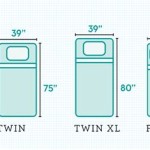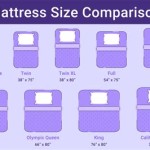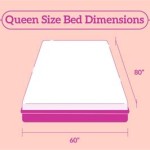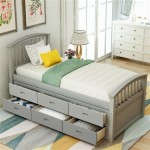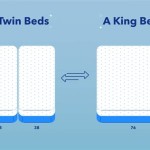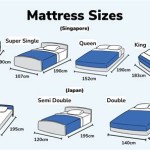Small Double Size Bed Dimensions: A Comprehensive Guide
The selection of a bed is a crucial decision impacting both the aesthetics of a bedroom and the quality of sleep. Among the various size options, the small double bed presents a compelling choice for individuals or couples with limited space. Understanding the dimensions of a small double bed, along with its benefits and considerations, is essential for making an informed purchase. This article aims to provide a comprehensive overview of small double bed dimensions, exploring their suitability for different scenarios and offering practical guidance for incorporating them into various bedroom layouts.
The term "small double bed," sometimes referred to as a "three-quarter bed" or a "queen single," falls between the dimensions of a standard single bed and a standard double bed. This intermediate size offers a viable solution for those seeking more sleeping space than a single bed provides, without the spatial demands of a full-sized double bed. Its dimensions make it particularly well-suited for smaller bedrooms, guest rooms, or situations where optimizing floor space is a priority. Before committing to a purchase, a thorough understanding of the precise dimensions is paramount.
The dimensions of a bed are not only important for fitting it comfortably within a room but also affect posture and comfort. The sleeper must be able to move freely without being constrained by the bed's limits, ensuring good sleep and physical health. By evaluating the specifics of a small double bed, buyers can make a good fit for their bedrooms and bodies.
Navigating the world of bed sizes can be confusing, as terminology and dimensions may vary slightly across different manufacturers and regions. It is crucial to verify the exact measurements before making a purchase, especially when ordering online. Reputable retailers typically provide detailed product specifications, including the overall dimensions of the bed frame and the recommended mattress size. These measurements often provide the length, width, and height, which are all important to the overall fit and use of the bed.
Typically, a small double bed measures approximately 4 feet (48 inches or 120 cm) in width and 6 feet 3 inches (75 inches or 190 cm) in length. While these dimensions represent a standard, slight variations may occur depending on the manufacturer and the design of the bed frame. For example, some bed frames may have additional features, such as a headboard or footboard, which can increase the overall length or width of the bed. These extended elements must be taken into account when determining whether the bed will fit comfortably within the available space.
When planning to buy a new bed, it is helpful to take the time to understand the dimensions so you can avoid any issues with space or comfort after buying. Accurate measurements of the room and consideration of the bed's role within the room will help ensure satisfaction with the purchase.
Key Point 1: Spatial Efficiency and Room Size Considerations
The primary advantage of a small double bed lies in its spatial efficiency. Compared to a standard double bed, which typically measures 4 feet 6 inches (54 inches or 135 cm) in width, a small double bed offers a narrower profile, saving valuable floor space. This difference of 6 inches may seem minor, but it can significantly impact the perceived spaciousness of a smaller bedroom. In rooms where space is at a premium, the benefits of a small double bed are considerable. These beds do not encroach on the living area as much as larger ones do.
Before deciding on a small double bed, it is vital to assess the dimensions of the bedroom and consider the placement of other furniture. Measure the room's length, width, and height, noting any architectural features such as windows, doors, or radiators that may affect the placement of the bed. It is recommended that one allows for adequate clearance around the bed, ideally at least 2 feet on each side, to facilitate easy movement and access. This clearance helps in making the bed and allows ease of navigating the room without stumbling. It makes the room easier to use and more comfortable.
Visualizing the placement of the bed within the room can be aided by using masking tape to mark out the bed's dimensions on the floor. This simple technique allows one to get a sense of the bed's footprint and how it will interact with the existing furniture and the overall flow of the room. This method also can reveal unforeseen limitations or opportunities for optimizing the layout, ensuring that the bed fits comfortably and does not overwhelm the space. Using the tape method helps to avoid any surprises related to the placement of furniture after the delivery.
Small double beds are especially suitable for guest rooms, studio apartments, or smaller bedrooms where a full-sized double bed would feel too cramped. These beds provide a comfortable sleeping surface for one person or a cozy option for couples, without sacrificing valuable floor space. In guest rooms, a small double bed strikes a balance between comfort for guests and efficient use of space when the room is not occupied. The size makes it a viable option for occasional guests.
When choosing a small double bed for a shared bedroom, its dimensions must allow adequate personal space for multiple occupants. When both occupants want space to move on their own, a small double may cause a squeeze, which is why it is essential to consider space and potential comfort.
Key Point 2: Mattress Selection and Bed Frame Compatibility
Once one has determined that a small double bed is the appropriate size for the bedroom, the next step involves selecting a suitable mattress. It is crucial to choose a mattress that is specifically designed to fit the dimensions of a small double bed frame. Using a mattress that is too large or too small can compromise the bed's structural integrity and affect sleep quality. The mattress should fit snugly within the bed frame, without any gaps or overhangs.
Small double mattresses are readily available from most major mattress retailers. When shopping for a mattress, one should pay attention to the dimensions specified in the product description and compare them to the internal dimensions of the bed frame. A mattress that is slightly smaller than the bed frame is preferable to one that is too large, as it will allow for easier sheet changes and prevent the mattress from being compressed or damaged. A mattress that is too big may not fit into the bed frame and will be uncomfortable.
The type of bed frame and its design can also influence the choice of mattress. For example, platform beds, which have a solid or slatted base, typically require a mattress that is the same size as the platform. In contrast, beds with a sprung base may allow for a slightly smaller mattress, as the springs can compensate for any minor size discrepancies. Bed frames that are constructed with storage space integrated with them may further limit which mattresses can be used. A mattress with a compatible thickness and weight should be chosen for use with a bed frame that has storage functions.
In addition to size, one should also consider the firmness and material of the mattress. Mattress firmness is subjective and depends on the personal preferences and sleeping style. Some people prefer a firm mattress for support, while others prefer a softer mattress for cushioning. The material of the mattress, such as memory foam, latex, or innerspring, can also affect its comfort and durability. It is recommended that one tries out different types of mattresses before making a purchase to ensure that it provides the desired level of comfort and support. Spending time testing the mattress may help in finding the preferred feel and prevent later dissatisfaction.
Mattress depth is often overlooked but it is important to consider alongside the bed frame. A really deep mattress will raise the sleep platform higher above the floor. For older buyers or those with restricted movement, it may be difficult to climb into a greatly elevated bed. Before settling on a mattress, take into account the bed frame and its depth.
Key Point 3: Styling and Design Considerations for Small Double Beds
A small double bed can be styled to complement a variety of bedroom aesthetics, from modern minimalist to traditional and cozy. The choice of bedding, headboard, and accessories can significantly impact the overall look and feel of the room. When decorating a bedroom with a small double bed, it is important to consider the scale and proportion of the furniture and accessories to create a cohesive and balanced design. The choice of bedding, headboard type, and use of bedroom accessories can help define the personality of the room and should be done with an eye toward style and functionality.
When selecting bedding for a small double bed, one should choose sheets, duvet covers, and pillowcases that are specifically designed for this size. Using bedding that is too large can make the bed look cluttered and overwhelm the space, while bedding that is too small can look skimpy and uninviting. A variety of bedding options are available in small double sizes, including fitted sheets, flat sheets, duvet covers, and pillowcases. When selecting bedding materials, one should consider factors such as comfort, breathability, and durability. Natural fibers such as cotton and linen are popular choices for their softness and breathability, while synthetic fibers such as polyester are more durable and wrinkle-resistant. Coordinating colors and patterns can add visual interest and personality to the bed. The aim should be to create a cohesive look through all aspects of the bedclothes to make the bed appealing.
The choice of headboard can also significantly impact the style of a small double bed. Headboards are available in a variety of materials, styles, and heights. Upholstered headboards can add softness and texture to the bed, while wooden headboards can create a more traditional or rustic look. Metal headboards can provide a modern and minimalist feel. When selecting a headboard, one should consider the overall style of the bedroom and the desired aesthetic of the bed. A taller headboard can create a more dramatic focal point, while a shorter headboard can be more subtle and understated. The headboard can be a centerpiece that sets the style for the entire bedroom.
Accessories such as throw pillows, blankets, and bedside lamps can also enhance the style and functionality of a small double bed. Throw pillows can add color, texture, and comfort to the bed, while blankets can provide warmth and coziness. Bedside lamps can provide both ambient lighting and task lighting for reading or other activities. When selecting accessories, one should consider the overall color scheme and style of the bedroom. Coordinating accessories can create a cohesive and harmonious look, while contrasting accessories can add visual interest and personality. Use of bedside lamps as well as accent throws contribute to both the use and the aesthetic of the room.
The placement of the bed within the room can also affect its overall style. Traditionally, the bed is placed against the longest wall in the room. However, in smaller bedrooms, this may not always be feasible or desirable. Experimenting with different bed placements can help one find the most functional and aesthetically pleasing arrangement. Placing the head of the bed in front of a window can be a way to create a feeling of spaciousness in a small area. Conversely, placing the bed in the center of the area may make it the focal point of the room. In all cases, the overall room design should be considered during the arrangement of the furniture.

Double Cot Dimensions

Mattress Sizes Chart And Bed Dimensions Guide Amerisleep

What Size Is A Small Double Bed Right Beds

Mattress Sizes Uk Guide For Perfect Bedroom Fit

Full Bed Vs Double

The Ultimate Guide To Adult Bed Sizes What Katy Said

Uk Bed And Mattress Size Guide Sizing Aspire

What Size Bed Is Right For My Child Cuckooland

Kozee Sleep B2b Bed And Mattress Manufacturers

Uk Bed Mattress Size Guide Consultant

